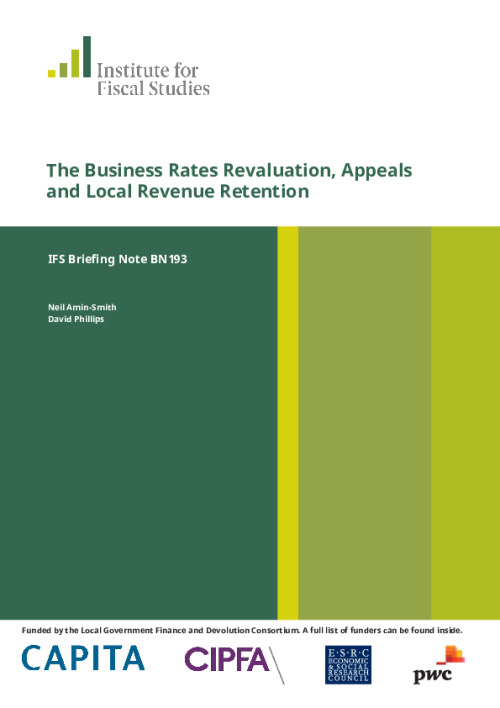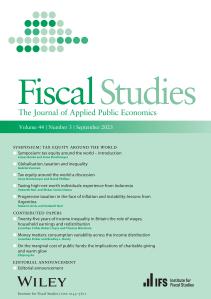For the last seven years, the business rates that occupiers of non-residential property have paid have been based on the value of their property in 2008. From April 2017, updated property values as of 2015 will be used to calculate rates bills. While the revaluation is meant, as far as possible, to be revenue-neutral (redistributing rates bills according to changes in relative rental values of properties), individual occupiers will see major changes in their rates bills. Because the changes in average value have varied significantly, there will also be big changes in the business rates revenues raised in different council areas, which requires that an adjustment is made to the business rates retention system (BRRS), which allocates a proportion of business rates to councils. Appeals by occupiers against their new rateable values will also pose a financial risk to councils, despite an increase in the headline business rates tax rate (the multiplier) to fund the cost of these appeals.
Key findings
| Across England as a whole, revaluation will lead to an 11% (cash-terms) increase in the rateable value of the average non-domestic property. | Changes in values are very unevenly distributed though. At a regional level, the largest increases are in inner London (28.4%), with values falling in the North East (–0.9%). More generally, property values are estimated to have gone up by more in the south and midlands than in the north, and by more in the central parts of urban areas than in their hinterlands. | |
| The business rates ‘multiplier’ will be adjusted so that the revaluation is revenue-neutral, after accounting for a forecast of the costs of appeals against the new values assigned to properties. | This means that the immediate effect of the revaluation will be to increase revenues and the average rates bill by around 4.6%, on top of inflation. The additional revenues raised up front will then be used to fund the cost of successful appeals further down the line. These costs include refunds for ‘overpayments’ of people who successfully appeal their rateable values. | |
| Revaluation would lead to average bills increasing in London (16%), the South East (4%) and East Midlands (2%), and falling in the other regions of England, after this adjustment. | However, as ratepayers successfully appeal against their rateable values, these bills and revenues will eventually come down. The figures published by the government – which show London as the only region where average bills and revenues will increase (by 11%) – are based on assumed bills after appeals, under the assumption that each region sees appeals in line with the government’s forecast for England as a whole. | |
| A complex package of transitional relief will phase in the biggest increases in bills. After accounting for such reliefs, revenues and the average bill in London will rise by 12% above inflation in the first year following the revaluation, 2017–18. | Transitional relief is paid for by phasing in rates cuts for other taxpayers. In 2017–18, these ‘caps’ to cuts will fully offset the 6% reductions in revenues and average bills in the North West and Yorkshire & the Humber that are implied by the revaluation itself. Individual rates payers due a large cut in bills will, of course, still see some cut, just not as much as they would if the transitional relief scheme did not exist. | |
| More frequent revaluation of properties could provide a better way of smoothing the shock of big overnight changes in values and bills than transitional relief. | This is because, in general, it takes time for large changes in property values to occur. More frequent revaluation would also mean that rates bills are based on more up-to-date information on local economic conditions – whereas transitional relief delays that adjustment process. | |
| The impact of the revaluation on the amount of business rates retained by individual councils under the BRRS will be offset by changes to the redistributive ‘tariffs’ and ‘top-ups’ between councils, with the aim of leaving their budgets unaffected by revaluation. | This will prevent some large overnight cuts (and increases) to councils’ budgets. It also avoids the risk that councils will try to constrain the supply of local properties to push up rents, values and hence their revenues. But it means councils have less incentive to boost demand for existing properties: they do not benefit from the resulting increases in rents and values. This suggests devolution of other revenues may need to be considered if broader incentives for growth are seen as desirable. | |
| The unequal pattern of growth in rateable values and revenues means that the amount of redistribution of business rates revenues the BRRS needs to undertake will increase slightly. | The total amount of top-ups required will increase from £4.2 billion to £4.4 billion. London councils will see an increase in their net tariff of almost £400 million to £730 million, while councils in the north will get bigger top-ups. This reflects a more general trend towards greater reliance on London for government revenues. | |
| For the majority of councils that see a relative reduction in the amount of business rates they collect following the revaluation (and an increase in their top-up or decrease in their tariff), fiscal incentives to boost local growth will weaken. | This is because their own business rates revenues will be a relatively less important source of their overall funding. Conversely, incentives will strengthen for those councils that see a relative increase in the amount of rates they collect. More generally, the BRRS implies very different fiscal incentives for growth in different parts of the country. | |
| Presently, the BRRS requires councils to bear the risk associated with appeals against rateable values in their areas. | In order to cover the cost of appeals in their area, councils will retain their share of the additional 4.6% business rates raised by increasing the multiplier. This means they will bear the risk of appeals in their area being higher or lower than this forecast for the average cost across England as a whole. | |
| During the first three years of the BRRS (2013–14 to 2015–16), there was significant variation in the amount councils put away in ‘provisions’ for appeals and in the proportion of these provisions they have had to use. | This suggests that the financial risk associated with appeals is large and difficult to forecast. Furthermore, appeals have been a little larger, on average, in areas that saw big increases in their bills at the last revaluation (in 2010). If this pattern holds again, areas that have seen large increases in rateable values and bills, such as inner London, may be especially likely to find the extra revenues collected up front insufficient to cover the costs of appeals. | |
| The government is currently consulting on ‘centralising’ the risk associated with appeals that are backdated to the start of the relevant rating list, coming into effect when councils move to retaining 100% of business rates in April 2019. | This proposal would insulate councils from a risk – valuation errors – that is largely outside their control. It would also remove the temptation for councils to ‘game’ the appeals system by initially over-providing for appeals, claiming ‘safety-net’ payments from central government, and then releasing the provisions at a later date (a temptation that would have increased under 100% retention). |











